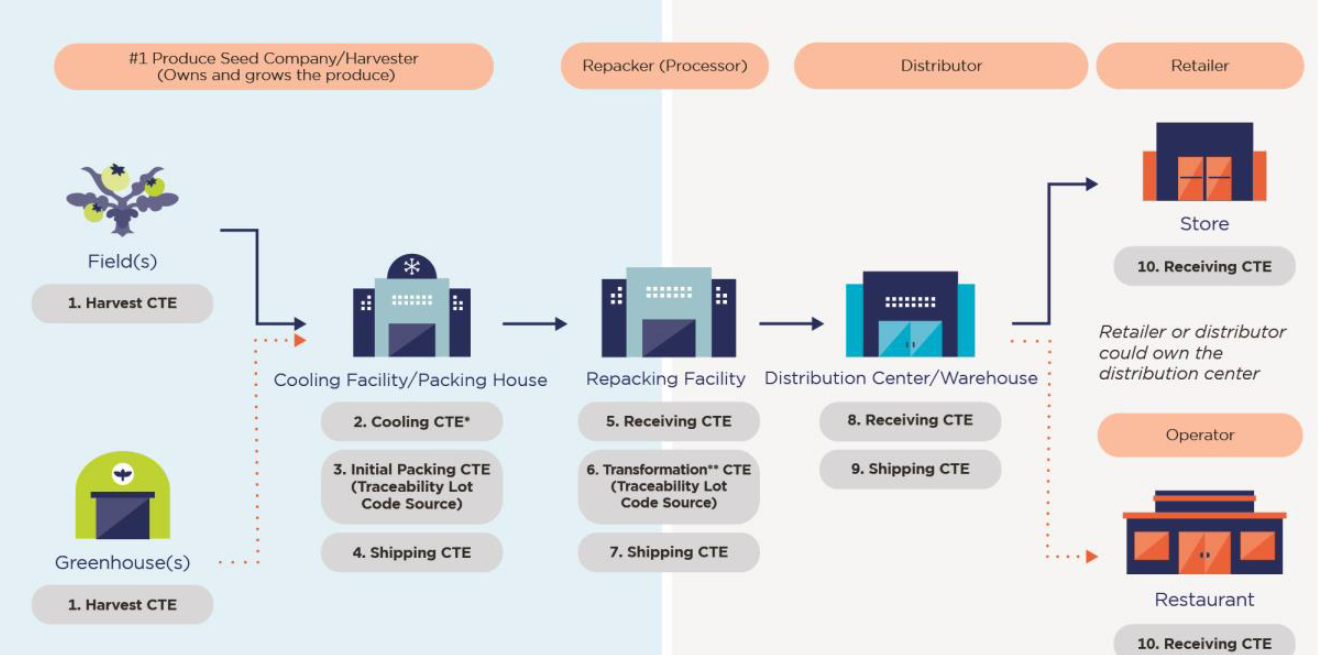New Food Traceability Final Rule to Improve Food Safety, Expedite Recalls and Protect Public Health
4 Min Read By Liz Sertl
How much information do you have about the foods your company handles in the course of business? If subjected to a food recall, would you be able to produce clear records delineating every touchpoint where the food was produced, harvested, processed or transformed, shipped, received, and used? How long would it take you to produce all that information when the FDA came calling?
When a foodborne illness outbreak occurs, a complete record of such information is needed to quickly identify a contamination source and trace affected products’ movement through the supply chain so they can be found quickly and removed from distribution. To ensure availability of such traceback data for “high-risk” foods, in particular, the US Food and Drug Administration (FDA) published the “Requirements for Additional Traceability Records for Certain Foods” (Final Rule) in November 2022, and is a key component of FDA’s New Era of Smarter Food Safety Blueprint and implements Section 204(d) of the FDA Food Safety Modernization Act (FSMA).
The Final Rule requires companies that physically handle certain foods across the supply chain to keep additional records, which can assist in tracebacks during an investigation or recall. The requirements do not apply to all foods, but to a subset listed in the FDA’s Food Traceability List (FTL) and to foods that contain listed foods as ingredients. These include soft cheeses, fresh/cut produce, shell eggs and nut butters, seafood and ready-to-eat deli salads, among others.
According to the Final Rule, companies that manufacture, pack, process, or hold FTL foods are required to maintain specific information (key data elements or KDEs) for certain critical tracking events (CTEs) in the food’s supply chain. The information required varies depending on the type of supply chain activities a company performs, from harvesting or production of food through processing, distribution, and receipt at retail or other points of service. This framework forms the foundation for effective and efficient tracing and clearly communicates the information that FDA needs to perform it.
Supply chain partners are required to maintain the data in their systems for two years and provide it to the FDA within 24 hours in the event of an outbreak. The FDA set a compliance deadline of January 20, 2026.
In response, members of the food industry in the US are preparing their systems and business processes to meet the Final Rule’s requirements. Specifically, many food supply chain stakeholders have been implementing or exploring the benefits of using the following GS1 Standards and business solutions:
- Global Trade Item Number® (GTIN®) for unique product identification.
- Global Location Number (GLN) for unique party and location identification.
- Global Data Synchronization Network™ (GDSN®) and Global Data Model (GDM) for consistent and accurate descriptions of products.
- Electronic Data Interchange (EDI) and Electronic Product Code Information Services (EPCIS) for structured data capture and sharing internally and among trading partners.
More than 65 organizations of the GS1 US retail grocery and foodservice industry initiatives, including leading manufacturers, distributors, retailers, foodservice operators, solution providers, and industry associations have worked together to analyze business processes and business requirements and consider how the standards can be applied to support requirements outlined in the Final Rule. The result of this effort is summarized in a new guideline published by GS1 US, “Application of GS1 System of Standards to Support FSMA 204.” The guideline defines the best practices for product and location identification, structured product descriptions, and the recording of common industry-defined events to support the additional traceability requirements.
Until now, each company’s chain of custody record-keeping requirement has been characterized as “one up, one down,” per the 2002 Public Health Security and Bioterrorism Preparedness and Response Act (Bioterrorism Act). The Final Rule means that companies will need to integrate data records from other trading partners with your own. Interoperability is going to be essential for the records to be coherently transmitted and catalogued. Leveraging GS1 Standards provides consistency and interoperability across different environments and systems while meeting a wide variety of business needs.
With key supply chain data embedded in barcodes that can be scanned at each point in the supply chain, automated data capture in digital, standardized format becomes available for sharing between trading partners. The data travels with the product.
Example: Traceability for Ready-to-Eat Salad
The ready-to-eat salad, end-to-end traceability process below depicts produce being harvested from more than one facility. The produce is placed into totes and sent to a cooling facility/packing house where it may be sorted/graded and shrink-packed into cases for cooling; with initial packing, traceability lot codes are assigned. Cooling is identified as a CTE if that step takes place. The packing house ships to the processor/re-packer where a transformation may occur, and new TLCs are assigned. The cases are shipped to a distribution center and then to retail outlets or restaurants.

Entities handling FTL foods should start now communicating with their supply chain partners to begin understanding existing recordkeeping systems and sharing capabilities, so that all required data can be made available when it is needed.
No one enjoys paperwork, and this traceability rule may seem like yet another administrative duty that has to be folded into an already complex workflow. The good news is, once your systems are set up to capture and share the data with a sortable spreadsheet (at minimum) the actual execution of an investigation will be easier, faster, and more accurately targeted. A lot of scrambling will be avoided when this process is fully integrated across the entire supply chain and trading partners are able to share it.
To learn more about enabling traceability for food safety by leveraging GS1 Standards, please visit www.gs1us.org/foodsafety.


